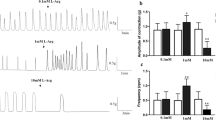Abstract
ELECTRICAL measurements in guinea-pig taenia coli indicate that the smooth muscle cell membrane is less permeable to ethanesulphonate (C2H5SO3) and benzene-sulphonate (C6H5SO3) and more permeable to nitrate (NO3) than it is to chloride (Cl). This conclusion is based on the following observations. (a) The membrane is depolarized by about 7 mV when Cl in Krebs solution is replaced with C2H5SO3, and is hyperpolarized by 6 mV with NO3 substitution for Cl (ref. 1). (b) The maximum change of the membrane potential per ten-fold change of the external K concentration is 47 mV in C2H5SO3, 38 mV in Cl and only 15 mV in NO3 (ref. 1). (c) The membrane resistance is higher in C2H5SO3 or C6H5SO3, and lower in NO3 than in Cl Krebs solution (unpublished results of Bülbring and Tomita).
Similar content being viewed by others
References
Kuriyama, H., J. Physiol., 166, 15 (1963).
Brading, A. F., and Setekleiv, J., J. Physiol., 195, 107 (1968).
Casteels, R., and Kuriyama, H., J. Physiol., 184, 120 (1966).
Casteels, R., thesis, Univ. Oxford (1965).
Conway, E. J., and Moore, P. T., Nature, 156, 170 (1945).
Author information
Authors and Affiliations
Rights and permissions
About this article
Cite this article
BRADING, A., TOMITA, T. Effect of Anions on the Volume of Smooth Muscle. Nature 218, 276–277 (1968). https://doi.org/10.1038/218276a0
Received:
Issue Date:
DOI: https://doi.org/10.1038/218276a0
- Springer Nature Limited





